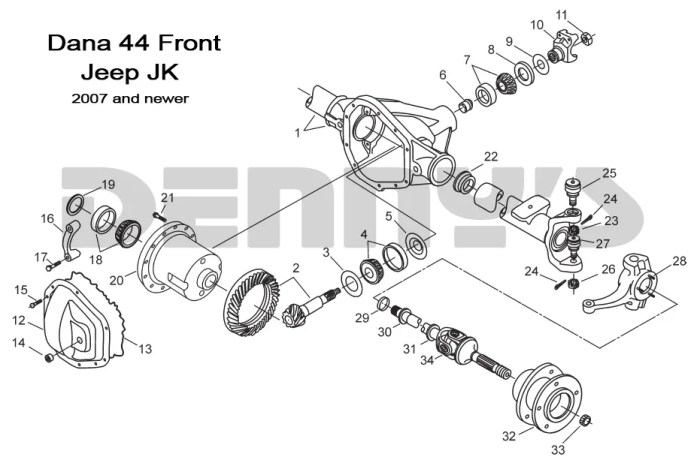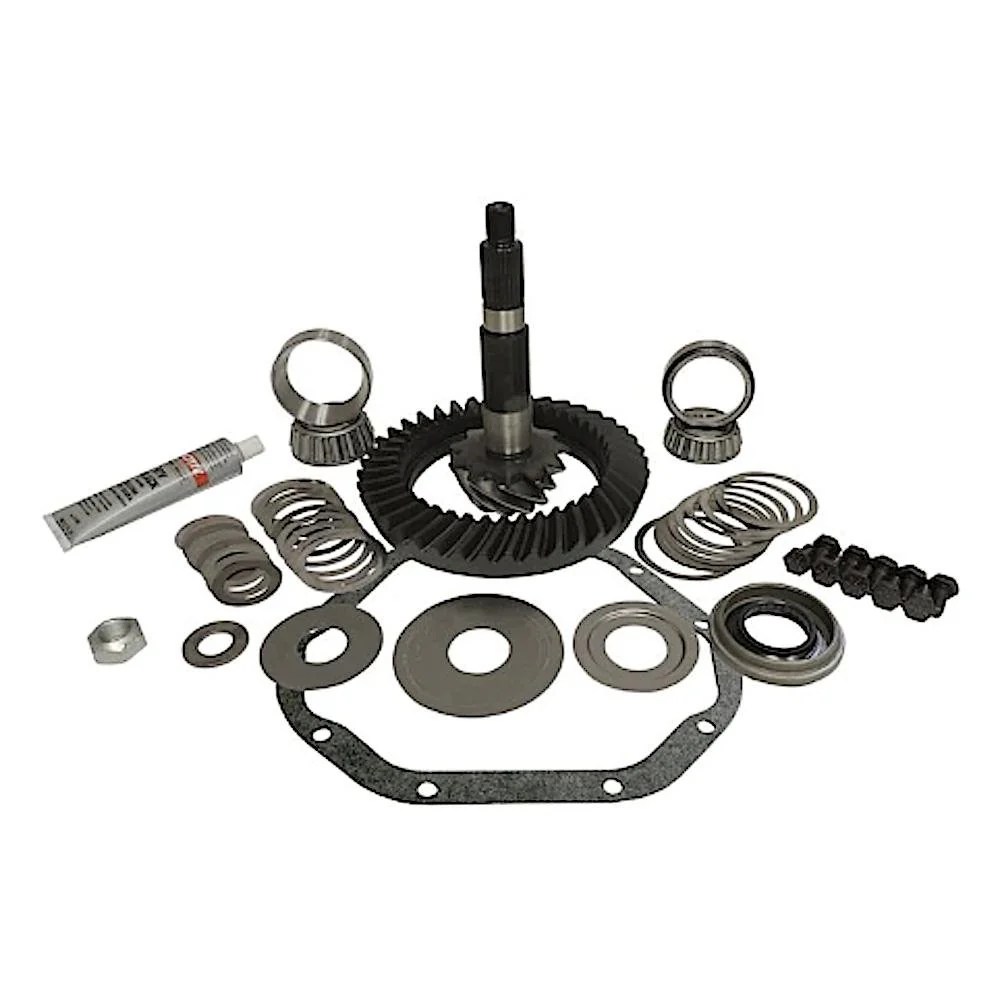Jeep axle parts are the backbone of off-road capability, transforming a vehicle from a simple car into a rugged adventurer. Understanding their function, maintenance, and potential upgrades is crucial for any Jeep owner, whether tackling challenging trails or simply ensuring reliable daily driving. This guide explores the various components, common issues, and solutions related to Jeep axles, providing insights for both novice and experienced enthusiasts.
From the robust Dana 44 to the more modern variations, Jeep axles represent a critical engineering element. Their design and construction directly impact the vehicle’s handling, traction, and overall performance, particularly in demanding off-road situations. We’ll delve into the specifics of axle shafts, differentials, bearings, and other key components, explaining their roles and how they interact to provide the legendary Jeep off-road experience.
Jeeps, renowned for their off-road prowess, rely heavily on their axles for exceptional performance. Understanding the intricacies of Jeep axle parts is crucial for maintaining optimal functionality, improving off-road capability, and ensuring the longevity of your vehicle. This comprehensive guide delves into the various components, common issues, and upgrade options related to Jeep axles.
Understanding Jeep Axle Types and Configurations
Jeep axles come in various configurations, each designed to suit specific needs and terrains. Knowing the type of axle in your Jeep is the first step towards proper maintenance and upgrades.
Dana 30 and Dana 44 Axles: The Workhorses
The Dana 30 and Dana 44 are arguably the most common axles found in Jeep Wranglers and other Jeep models. The Dana 30, typically found in front axles of lighter Jeeps, is known for its relatively lighter construction. The Dana 44, often used in heavier-duty applications and rear axles, offers significantly increased strength and durability. Both are available in various configurations, including high-pinion and low-pinion designs, each impacting ground clearance and performance.
Chrysler 8.25″ and AMC 20 Axles: Alternative Options
Other axles like the Chrysler 8.25″ and AMC 20 have also seen use in various Jeep models. The Chrysler 8.25″ is known for its robust design, particularly in the rear axles of heavier Jeeps. The AMC 20, while less robust than the Dana 44, served as a common rear axle in several Jeep models. Understanding the specific axle in your Jeep is vital for selecting the right parts and upgrades.
Key Components of a Jeep Axle Assembly
A Jeep axle assembly is comprised of numerous interconnected parts, all working in concert to transfer power to the wheels and provide the necessary articulation for off-road driving. Let’s explore some of the critical components:

Axle Shafts: Power Transfer
Axle shafts are responsible for transferring power from the differential to the wheels. These shafts experience significant stress, especially during off-road driving, making their condition critical. Common issues include bending, breakage, and wear on the splines. Upgrading to stronger chromoly shafts is a popular modification for increased durability.
Differential: Power Distribution
The differential is the heart of the axle assembly. It allows the wheels to rotate at different speeds during turns, preventing tire scrubbing and damage. Key components within the differential include the ring and pinion gears, carrier, and differential bearings. Proper gear mesh and bearing condition are essential for optimal performance and longevity. Upgrading the gears with a higher gear ratio can improve performance, but requires careful selection to match the application.
Axle Housings: Protection and Support
The axle housing provides structural support and protection for the internal components of the axle. These housings can be prone to damage from impacts, especially during off-road driving. Repair or replacement of a damaged axle housing is often a significant undertaking.
Axle U-joints (Universal Joints): Articulation
U-joints allow for the articulation needed for off-road driving, enabling the axle shafts to move at varying angles. These joints are subject to wear and tear and require periodic lubrication and replacement. Symptoms of worn U-joints include clunking noises and vibrations.
Wheel Bearings: Smooth Rotation
Wheel bearings ensure smooth wheel rotation and support the weight of the vehicle. These bearings are crucial for safe and efficient operation. Regular inspection and replacement are essential to prevent premature wear and failure. Symptoms of bad wheel bearings include rumbling noises and excessive play in the wheels.
Other Critical Components, Jeep axle parts
Beyond the core components, several other parts contribute to the overall functionality of the Jeep axle assembly. These include axle seals (preventing leaks), brake components (integrated into the axle), and various fasteners and hardware. Regular maintenance and inspection of all components are critical for optimal performance and safety.
Common Jeep Axle Problems and Solutions
Jeep axles, particularly those subjected to rigorous off-road use, are susceptible to various issues. Early detection and prompt repair are crucial to prevent more extensive damage.
Axle Shaft Damage: Bending and Breakage
Bent or broken axle shafts are a common problem, especially during high-stress situations. This often requires replacement with stronger aftermarket shafts.
Differential Issues: Gear Wear and Bearing Failure
Worn gears or failed bearings in the differential can lead to noise, vibration, and ultimately, axle failure. Repair or replacement of the affected components is necessary.
U-Joint Wear: Clunking and Vibration
Worn U-joints produce characteristic clunking noises and vibrations. Replacing worn U-joints is a relatively straightforward repair.
Axle Seal Leaks: Fluid Loss
Leaking axle seals lead to fluid loss, which can damage the internal components of the axle. Replacing the seals is essential to prevent further damage.
Upgrading Your Jeep Axles: Enhancing Off-Road Capability
Many Jeep owners upgrade their axles to enhance off-road capability and durability. Several options are available, depending on the budget and desired level of performance.
Aftermarket Axle Shafts: Increased Strength
Upgrading to stronger chromoly axle shafts significantly improves durability and reduces the risk of breakage during extreme off-road driving.
Gear Ratio Changes: Improved Performance
Changing the gear ratio in the differential can improve performance for specific terrains. A lower gear ratio improves low-speed torque, while a higher gear ratio improves high-speed performance. This choice depends on your typical driving conditions.
Locker Installation: Enhanced Traction
Installing lockers (either selectable or automatic) forces both wheels on an axle to rotate at the same speed, providing maximum traction in challenging off-road situations.
Complete Axle Assemblies: A Comprehensive Upgrade
For a complete overhaul, replacing the entire axle assembly with a stronger aftermarket unit provides the most significant improvement in strength and performance. This option is generally more expensive but offers superior durability.
Frequently Asked Questions (FAQ)
- Q: How often should I inspect my Jeep axles? A: Regular inspections, ideally before and after each off-road trip, are recommended. Look for leaks, unusual noises, and signs of damage.
- Q: What are the signs of a bad Jeep axle? A: Common signs include unusual noises (clunking, grinding, whining), vibrations, leaks, and reduced traction.
- Q: How much does it cost to replace a Jeep axle? A: The cost varies significantly depending on the axle type, the extent of the damage, and the labor costs. Replacing an entire axle assembly can be quite expensive.
- Q: Can I replace Jeep axle parts myself? A: Some repairs, such as replacing U-joints or axle seals, are relatively straightforward for those with mechanical experience. However, more complex repairs, such as differential work, should be left to qualified mechanics.
- Q: What are the benefits of upgrading my Jeep axles? A: Upgrading can significantly improve off-road performance, durability, and strength, allowing for more challenging terrain.
Conclusion: Jeep Axle Parts
Jeep axles are critical components for off-road performance and reliability. Understanding their function, common problems, and upgrade options is crucial for maintaining your Jeep’s capability and longevity. Regular maintenance, proactive inspections, and timely repairs are essential for ensuring your Jeep continues to perform at its best.
Call to Action
Ready to upgrade your Jeep’s off-road capabilities? Contact us today to learn more about our range of Jeep axle parts and services! We can help you select the right components for your needs and budget.
Helpful Answers
What are the signs of a failing Jeep axle?
Signs include unusual noises (clunking, grinding), vibrations, axle shaft play, leaking fluids, and difficulty steering or maintaining traction.

How often should I inspect my Jeep axles?
Regular inspections, at least every 6 months or 6,000 miles, are recommended, especially if you frequently drive off-road.
Can I replace Jeep axle parts myself?
While some simpler repairs are possible for DIY enthusiasts, more complex repairs often require specialized tools and expertise. Professional help is advisable for significant repairs.
